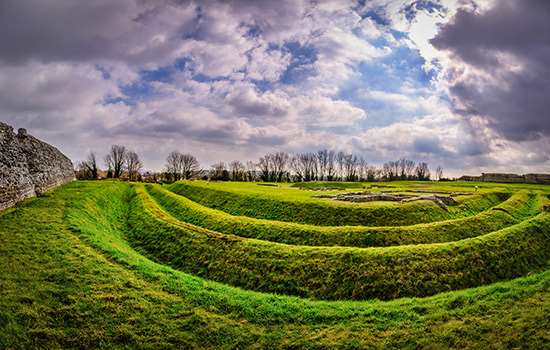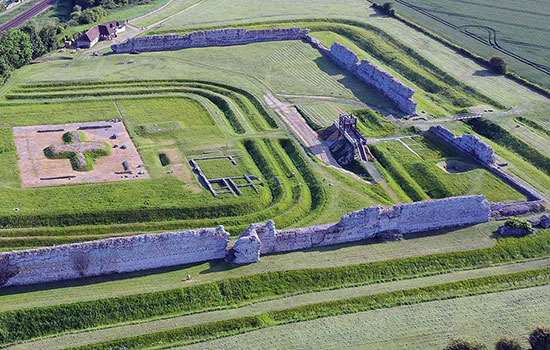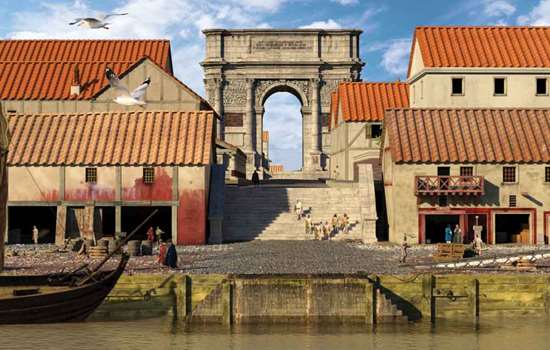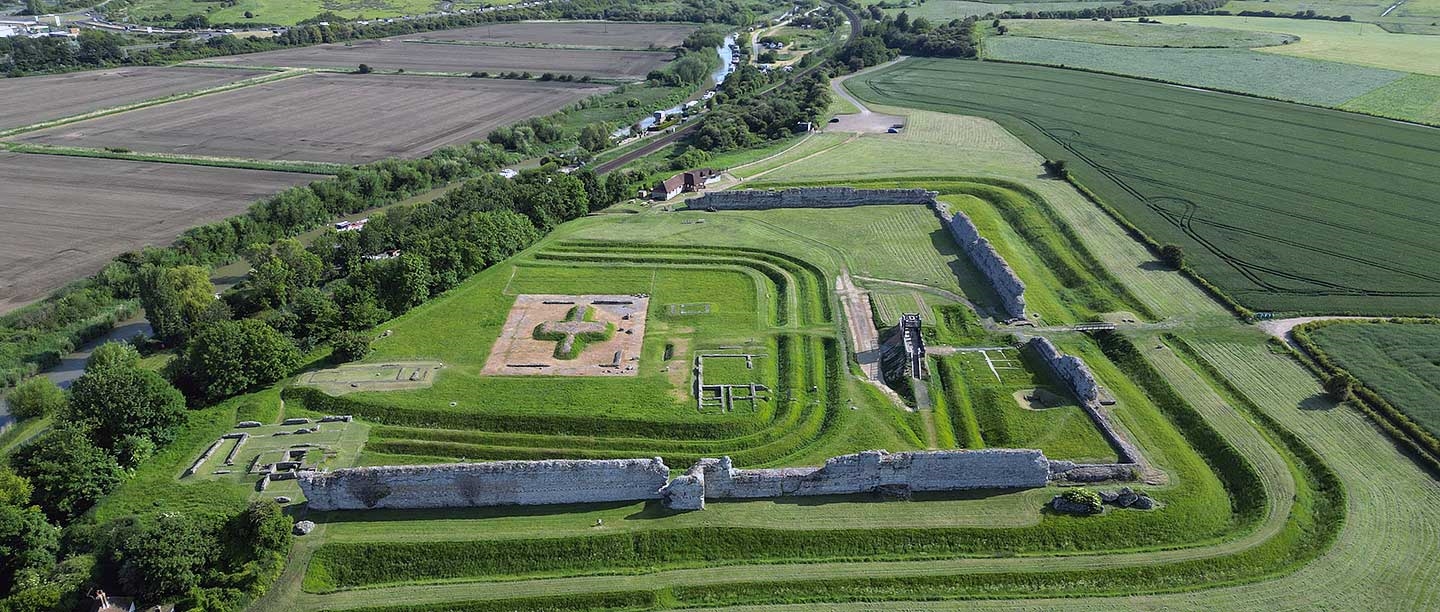Before the Romans
Before the Romans invaded, the islands of Britain had no single political or cultural identity. Many peoples lived in Britain, in large, independent tribal groups, led by powerful kings and queens. The tribes each controlled their own extensive territories and resources, and they did not always live in peace with one another.
The Romans had known about Britain long before they decided to invade. Julius Caesar came to know of its peoples during his wars in Gaul between 58 and 50 BC, which brought much of what are now France, Belgium, Luxembourg and Switzerland under Roman control. During that time, in 55 and 54 BC, Caesar undertook two military expeditions to Britain. Although these campaigns did not intend or result in conquest, he extracted tribute from some of the British tribes and gained knowledge of southern Britain’s natural resources and their potential value to Rome.
In the century after Caesar, contact between Britons and Romans increased. Some of the British tribes, such as the Atrebates of central southern Britain, developed political and trading relationships with Rome and adopted some Roman ways. Silchester (Hampshire) developed as a town with organised streets, its people importing Roman wine, olive oil and other products. Other tribes, such as the Catuvellauni, who were based further north and east, remained wary or opposed.
Imperial power
By the time of the emperor Claudius (reigned AD 41–54), the Roman army’s loyalty was firmly with the imperial family, where real power now lay. The Senate had been losing political force since 27 BC, when the Roman Republic came to an end. The army expected strength and military victories from all emperors, and as the engine of Roman power it made or disposed of emperors accordingly.
Tiberius Claudius Caesar Augustus Germanicus – Claudius – became emperor after the murder of his nephew Gaius (better known as Caligula) in AD 41. Claudius’ elevation was unexpected: he had been kept out of the limelight by his family who thought his disabilities, including slight deafness and a limp, made him unsuitable for public life. However, Caligula’s murder left Claudius as the only adult male of the Julio-Claudian dynasty, and the emperor’s bodyguards, the Praetorian Guard, proclaimed him emperor.
With an uncertain grip on power, Claudius needed to find a way to secure his position.
The power and the glory
The invasion of Britain was one of the ways Claudius set out to prove himself. His imperial predecessor, Caligula, had prepared for an invasion, but then abandoned the enterprise, in AD 41. The army took this as a failure, and a source of embarrassment and shame.
As a pretext for invasion, Claudius may have used the expulsion from Britain of the pro-Roman king, Verica of the Atrebates, by the Catuvellauni. Hostile to Roman influence, the Catuvellaunian brothers Caratacus and Togodumnus had been leading attacks on the Atrebates and extending their area of influence westwards from their homelands north of the Thames. This meant that a powerful anti-Roman party was gaining wider control of southern Britain.
For Claudius, a successful invasion would bring glory and popularity. It promised booty and access to the considerable natural resources of Britain, and it would also satisfy the army.
Underpinning the prospect of invasion was the Romans’ innate belief in their right to conquer non-Roman peoples. They were confident that the gods had gifted them the known world and that it was their right and duty to rule it all in their ‘civilised’ manner.
The landing place
Roman historical accounts of the invasion are few, brief and not entirely reliable. None is contemporary. The longest was written in Greek by the historian Cassius Dio, around AD 200. What we know of the invasion must therefore be pieced together from these sketchy written sources and the chance survival of archaeological evidence.
Boulogne is thought to have been the port of embarkation, though the mouths of the Somme and Seine rivers have also been suggested. According to Cassius Dio the invasion force sailed in three divisions. This was probably a practical solution to crossing the Channel, where the prevailing winds, tidal variations and long time required to marshal hundreds of ships safely demanded a phased movement to avoid chaos and confusion, and to allow sequenced and ordered landings.
Historians and archaeologists do not agree about where the Roman army landed. Most think a single place is more likely than three different points, on the basis that one landing would have concentrated the army’s strength. Chichester harbour on the south coast and Richborough in the south-east are seen as the most plausible locations. There is evidence of Claudian military occupation at both places, but the extreme difficulties of sailing a large fleet in the Channel probably favour Richborough, because the crossing was much shorter, and the prevailing wind and tide conditions were easier to negotiate. The Roman fortification of Claudian date known from archaeological work at Richborough, located on what was in AD 43 a small island adjacent to a large natural harbour, may have served to protect the soldiers and supplies during disembarkation.
The invasion army
The Roman general Aulus Plautius commanded an invasion force that probably comprised the heavy infantry of four Roman legions, numbering 20,000 soldiers, and a similar number of multi-purpose auxiliary troops, including cavalry, giving a total of about 40,000. The organisation required to transport such a large force of men, animals and supplies was immense. The Roman navy probably needed a fleet of between 700 and 1,000 transport ships and warships for the task.
The Roman army was a formidable machine. It had highly developed tactical capabilities to fight both disciplined set-piece battles and smaller tactical actions. Facing the Romans was a far less organised, but no less brave, British opposition of warriors on foot, in chariots and on horseback – who were fighting on ground familiar to them.
The military campaign
The likely landing locations suggest two possible scenarios for the campaign. If the landing was at Chichester, the aim may have been to restore the pro-Roman kingdom of the Atrebates in southern Britain, and then to march north to the Thames and down the Thames valley into the heart of Catuvellauni territory to capture Colchester, the Catuvellaunian capital. From Richborough, on the other hand, the Romans could have taken a shorter, more direct route along the North Downs, crossed the Thames near London, and marched on to take Colchester. The latter scenario is the most widely accepted.
Cassius Dio records two major battles. One of these, at a river crossing, involved Roman auxiliary cavalry swimming across with their horses to make a successful flank attack on the British warriors. The river Medway, which lay on the Roman route from Richborough, seems the most likely site for this battle, though the river Arun north of Chichester has been suggested too. Historians mostly agree that the second large battle was on the banks of the Thames and resulted in the defeat of the Catuvellauni.
Dio’s narrative also includes the submission of the Dobunni, a tribe centred in Gloucestershire, where Aulus Plautius established a Roman garrison.
Plautius summoned Claudius, who was probably waiting at Boulogne. Claudius arrived with his Praetorian cohorts – and, according to Cassius Dio, war elephants – to take part in the final assault on Colchester. Charging elephants were a formidable and terrifying sight in battle, particularly perhaps to the Britons, who would not have seen them before. Claudius’ arrival for the surrender of the Catuvellauni, and the disarming of other Britons, was enough to secure for him the military prestige required to consolidate his imperial throne.
Cassius Dio records that 11 British kings surrendered to Claudius. Caratacus escaped to fight again in later years, alongside warriors from other British tribes further north and west.
Aftermath
The Roman victory against the Catuvellauni and their allies enabled Claudius to return to Rome, according to Cassius Dio, after only 16 days in Britain. Dio goes on to say that Claudius’ arrival in Rome was to widespread acclaim. The Senate voted for a triumph (a public civil and religious celebration granted to successful military commanders), to build triumphal arches in Rome and Gaul, and to give Claudius the honorary title ‘Britannicus’ (though he never used it). The arches no longer exist, but some decorative sculpture survives from the one in Rome.
In Britain, however, the fighting continued. The Romans, already in control of the south-central and south-eastern part of the island, had secured East Anglia as a friendly client kingdom, without violence, and began to consolidate their gains with roads and forts. The army advanced north into the Midlands and west into what are now Wiltshire, Dorset, Devon, Somerset and Gloucester.
We have little historical evidence for the rest of this campaign. However, Suetonius, writing around AD 120, recorded a prominent role played by one of Plautius’ commanders, Titus Flavius Vespasianus (later the emperor Vespasian), with the legion II Augusta. Vespasian’s role after Colchester was probably in the west, because Suetonius mentions the Isle of Wight. Some of this campaign may have been conducted from a rear base at Alchester (Oxfordshire), where there is archaeological evidence for a legionary fortress. The fortress, which had an annexe added to it in the winter of AD 44/45, may have been built in AD 43. Another, more forward campaign fortress of legionary size is known at Lake Farm, Wimborne (Dorset), and there is a smaller fort inside a hillfort of the Durotriges tribe at Hod Hill (Dorset).
In the Midlands, archaeologists have located and excavated forts from the northern arm of the campaign, including one as far north as Longthorpe, near Peterborough, which may have been established before AD 47. By the end of that year – four years after the invasion – the Romans had military influence over a large area of lowland Britain, south of a broad corridor stretching from east Devon north-eastwards to the river Severn near Gloucester and onwards across the Midlands to the river Humber.
While the military campaign continued, the process of creating a Roman province was already beginning. Colchester, initially at least, became the capital of Britannia and Aulus Plautius was its first governor, remaining so until AD 47. His replacement, Publius Ostorius Scapula, was to take the conquest further, with both victories and setbacks – but that is another story, part of a 40-year period of military campaigning. It was not until around AD 85 that Rome had mastered much – though not all – of Britain.
By Paul Pattison
Related content
-

VISIT RICHBOROUGH ROMAN FORT AND AMPHITHEATRE
Richborough is perhaps the most symbolically important of all Roman sites in Britain, witnessing both the beginning and end of Roman rule.
-

HISTORY OF RICHBOROUGH ROMAN FORT AND AMPHITHEATRE
Read a full history of this key site, which witnessed over 360 years of Roman rule – the entire length of the Roman occupation of Britain.
-

ROMAN BRITAIN
Read an overview of the 400-year period when Britain was part of the Roman Empire, from AD 43 to the early 5th century.
